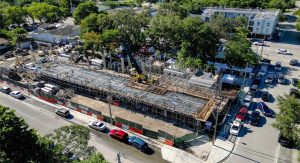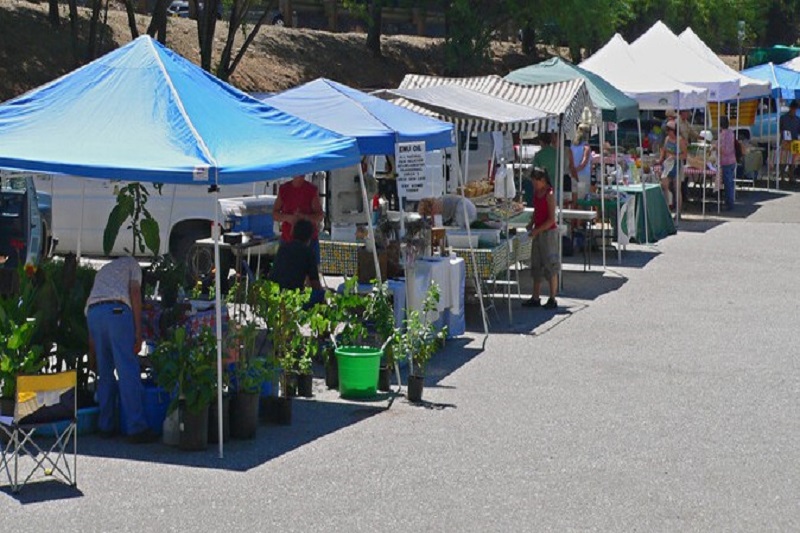Every Saturday, Kerwin Rowlins, “Coconut Man,” sets up shop in a corner of the Coconut Grove Organic Farmers Market with his brother.
Their stall overflows with piles of coconuts and ackee. A customer walks by on his way out of the Grand Avenue market, fist-bumping Rowlins and telling him to turn his music up. Rowlins nods and cranks up the reggae. A mom and her daughter approach the stand and ask for a fresh coconut. Rowlins grabs two big ones, one in each hand, weighing them by feel. He chooses the heavier coconut, picks up a knife, hacks open the hard shell. He pops a straw into the coconut and hands it over. Along with the reggae and laughter, the market fills with the sounds of food cooking and people chatting.
But all of this could soon be gone, as new development replaces Coconut Grove landmarks, piece by piece. The market, amid lush almond and live oak trees, feels almost immune from encroaching development. But the market’s history is also part of a larger story of a changing Coconut Grove.
New Development Next Door
In June, two rows of stalls at the market were pushed out to make room for the construction of a new apartment building, Elemi at Grove Village. The development broke ground on June 7.

When completed, Elemi will have 46 residences, one, two or three bedrooms. The building will also have a rooftop lounge, a pool deck and a communal outdoor kitchen. The two rows of the market that had to go sat on land owned by Silver Bluff, the development company building Elemi.
Before starting construction, the company let vendors set up on the property each week as a courtesy. Grant Savage, the founder of Silver Bluff, grew up in Coconut Grove. He said his company was up front with the market about the groundbreaking. Still, the development of Elemi next door left vendors wondering how long the rest of the market would last. Many worry that it will be shut down for new development — meeting the same fate as other Coconut Grove businesses and cultural spots.
Their fears aren’t unfounded. Development and gentrification have been changing the Grove for years. Bahamian immigrants settled in what is now known as the West Grove 150 years ago. For many years, it was a thriving community, drawing Black residents from North Florida and the deep South.

Grand Avenue, home to the Organic Market, is now a socioeconomic dividing line. The avenue, once a thriving center of commerce, is in varying shades of disrepair and development, with run-down homes next to newly built big-box stores. Alongside the mixed economy, the Black population of the Grove has plummeted in recent decades. The neighborhood’s Black population dropped more than 40% between 2000 and 2020, to 2,600, while the number of white residents shot up 178% to 2,150.
Those figure are from an analysis of U.S. Census figures by the University of Miami law school’s Center for Ethics and Public Service, which works with West Grove community groups. It’s not just the population of the Grove that’s changing, but also the culture. Once a “come as you are” community known for its eclectic collection of businesses, restaurants and architecture, the Grove has been getting richer and fancier.
Take Scotty’s Landing, the funky bayside watering hole demolished last year and replaced with sleek restaurants as part of the Regatta Harbour project. Or the Key West-style cottage lovingly called “Seaside,” built in 1909, which was torn down last year. Day by day, the Grove’s colorful bungalows are being torn down and replaced with luxury homes. These new homes, which many Groveites call “sugar cube” houses for their boxy white architecture, often sell for millions of dollars. Despite the rapid change happening all around it, the Coconut Grove Organic Market seems like a haven from the area’s development. It’s a place, for now, where people can get that old-school Grove feeling.
A Center Of Community
Rowlins, the Coconut Man, came to Miami in 1997 from Trinidad and Tobago, where he was born and raised. The market’s culture is what keeps him coming back every week to sell coconuts.
“So much different nationalities are here, which represents a lot of diverse culture, diverse knowledge, diverse food,” Rowlins said. “You learn from the different people you meet here, and there ain’t really places like this in South Florida or probably even in Florida itself.”
Sally Graves runs Compassion Be Dope, a business selling CBD and THC products at the market. Her stall stands out as a shock of color in the otherwise earth-toned market — her tent is hot pink, and filled with pink stickers, bandannas and straws to match. She wears a pair of dangly fuschia earrings.
“It’s unique because it’s in the Grove. We have these gorgeous, glorious trees,” Graves said. “It kind of separates us from other farmers markets that are typically in a parking lot. Boring — you’re on concrete! Here, you get to walk on gravel and sticks, you get to see iguanas in the trees. They pee on our tents!”
To Dasha Bostic, whose stall is a row away, the market is more than just the spot where she sells her ginger juices. It’s also where she grew up.
“I’ve been down here since I was 8,” Bostic said. “And ever since then, every week, it’s just been a part of my life.” Bostic’s mom used to sell homemade shea butter products at the market, and always brought Bostic along with her. She spent her Saturdays playing among the tree trunks and getting to know the other vendors.
In her 19 years of coming to the market, Bostic has seen it change along with the rest of the Grove.
How The Market Stayed As Coconut Grove Has Changed
While most other farmers markets shut down during the pandemic, the Coconut Grove Organic Market remained open, attracting vendors who couldn’t set up shop in their usual locations. The pandemic also gave entrepreneurs the free time to develop their business ideas, and the market offered a launch pad to test out a business in easy, small-scale ways.
An Uncertain Future
Stan Glaser of Glaser Farms, the manager of the market, could be mistaken for just another customer as he wanders through stacks of mangoes, papayas and okra. Glaser Farms, in South Miami-Dade, sells organic fruits, vegetables and raw prepared foods. They’re the largest vendor at the Coconut Grove Organic Market. After four decades as market manager, Glaser understands the business side of things.
“The land that we’re on right now is extremely valuable. It’s vacant land near the center of Miami, and there’s not a lot of that. It’s not something that a developer would buy to have a market,” said Glaser.
Because of that, Glaser explained, the market relies on his relationship with the land’s owner, Orlando Benitez of Grove Grand LLC, who the manager says is “very friendly.” The Miami Herald wasn’t able to reach Benitez for comment on the future of the organic market as new construction closes in.
But Glaser knows how tenuous these relationships can be if the land owner sees an opportunity for lucrative development. Glaser said the market used to be across the street, gesturing to a CVS Pharmacy on the other side of Grand.
“But the developers decided on a Thursday that we couldn’t be there anymore, and the market was going to be on Saturday,” said Glaser.
And just like that, with three days’ notice, the market was gone. After getting kicked off the original site, Glaser ended up leasing the current lot for the market, which at the time was owned by George Simpson, a Bahamian landowner. Though the market found a new home, Glaser still feels a sense of instability. Being kicked off the land “has always been imminent. We’ve never had a long-term contract. We’ve been month to month for 40 years, and all in areas where they want to build stuff like that.” He looked over at the Elemi construction site next door.
“I’m not sure why they allow that to happen in Coconut Grove,” Simpson said.
Many of the vendors share Glaser’s view. Graves pointed up at the trees cresting above her tent.
“You see some of these beautiful tall trees? Well, there used to be some right there,” said Graves.
She looked toward the construction site, where thick concrete columns now stand.
“Two huge, huge trees. The kids used to climb in them, and they were all cut down for development. They were fruit trees, there were jackfruit trees over here. It was amazing,” said Graves.
It’s a stark and symbolic image: concrete and metal beams in the construction site rising higher day by day while the market stays the same. The same white tents, the same trees, the same customers, week after week. Graves, like others, felt that she had to mourn the loss of these trees.
“I literally cried when that tree got knocked down. It was a stump and I had to go hold it and hug it and cry, like, thank you for being here,” said Graves.
Juan Paez, who alongside his mother sells guayusa tea and sea moss, says that most people don’t know what to think about the future of the market.
“It’s very concerning for a lot of the vendors here. We’re trying to stay positive,” Paez said. “There’s a lot of rumors going on, that this market isn’t going to last too long, or that it’s going to be going somewhere else. “We don’t know exactly where it’s gonna end up,” he said. “But right now we’re just attending every Saturday here.”
Information About The Market
When: Saturdays only, rain or shine, from 10:30 a.m. to 6:30 p.m.
Where: 3300 Grand Ave., Miami. Located on the corner of Grand Avenue and Margaret Street
Contact: 305-238-7747 connects you to Glaser Farms
Number Of Vendors: About 85
View the Miami Herald news story video regarding The Coconut Grove Organic Farmers Market below:
Source: Miami Herald

